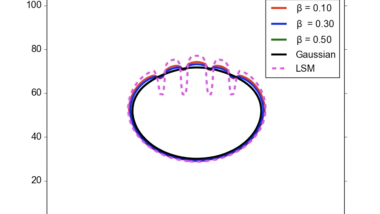SP
Statistical Physics
The research of the group falls into the topic of diffusion mainly through the development of stochastic processes in the framework of Fractional Calculus with application to anomalous diffusion and wildfire propagation.
Since the advent of modern Single Particle Tracking (SPT) techniques, a large amount of data with great temporal and spatial accuracy has been produced. The emergence of anomalous diffusion has been confirmed by SPT statistics in many biological systems, with sub-diffusive behavior often associated to crowding, confinement phenomena, and strong heterogeneity of the environment. Recent experiments on molecular diffusion within the cell environment permit to distinguish the anomalous behavior caused by active mechanisms, from the one caused by crowding and confinement in the same system. The research of the group aims to develop novel approaches to generate anomalous diffusive behavior by considering the role of heterogeneity.
News frequently report devastations caused by wildfires and at any time they are labelled as the greater since ever. Climate change has an important role in increasing the frequency of record-breaking fire seasons and, in this sense, there is no need to prove the emergencies generated by wildfires and then their timely understanding and managing. Fire may be an essential element of the ecosystem, or an unnatural element to be avoided. In any case, there is no "blame game" to be played because fire is part of the Earth system, and human dimensions of fire regimes are embedded in complex ecological, economic, political, technological and social relationships. Hence, the comprehension of fire requires to consider it a step in the long-term joint-evolution of the humankind and nature, and do not restrict its study to the description of the present conditions. Finally, the importance of fire in nature and the impacts of our decisions on the related issues call for an overcoming of disciplinary and conceptual boundaries that impede our understanding of the complexities of human-fire relationships. The research of the group aims to introduce proper modelling of random phenomena in the propagation of wildfires, as those due to turbulence or fire-spotting, that are implementable in operational wildfire simulators.

Equivalence in distribution of three Centre-of-mass like models for fractional diffusion [from D’Ovidio M., Vitali S., Sposini V., Sliusarenko O., Paradisi P., Castellani G., Pagnini G., Fract. Calc. Appl. Anal. 21, 1420–1435 (2018)]
Prueba de texto para las líneas de investigación con enlace
Research on anomalous/fractional diffusion is focused on a critical analysis of the generative mechanisms and the development of the corresponding stochastic processes. For example, power-laws mark distributions that do not belong to the domain of attraction of the Gauss law but to the general domain of the stable law or, alternatively, they reveal a compound probability distribution of Gaussian densities with power-law mixing distribution. These two statistical understandings reflect indeed a dualism in the generative mechanism. During the years, an approach for heterogeneous ensembles of particles - and based on the Langevin equation - was formulated to generate fractional diffusion.
Research on random front propagation is focused on modelling wildfire propagation in particular is focused on the role and the physical parametrization of turbulence and fire-spotting. A ready-to-use software code was developed which is implementable into operational simulators.
The random diffusivity approach for diffusion in heterogeneous systems
Front Propagation in Random Media
Stochastic processes for anomalous diffusion
Modeling of birth-death and diffusion processes in biological complex environments
Generalised gray Brownian motion
Simulate the stochastic process ggBm and do statistics on the trajectories
Authors: Daniel Molina García
License: If it depends on me: GPL3+
Placement
ggBm
Continuous Time random walk
Simulate the stochastic process CTRW and do statistics on the trajectories
Authors: Daniel Molina García
License: If it depends on me: GPL3+
Placement
CTRW
Langevin equation
Solve a Langevin equation
Authors: Daniel Molina García
License: If it depends on me: GPL3+
Placement
Langevin
LSFire+
Code for evolution of front in random environment
Authors: Andrea Mentrelli, modified by Andrea Trucchia
License: GPL or any Licence BCAM requires
Placement
Personal Laptop and Hypatia
LevelSetFenics
Code for evolution of front in deterministic environment
Authors: Andrea Trucchia
License: GPL or any Licence BCAM requires
Placement
Personal Laptop and Hypatia
Visualizer_tool
Code for visualization of several front propagation code outputs
Authors: Andrea Trucchia
License: GPL or any Licence BCAM requires
Placement
Personal Laptop and Hypatia
Ornstein-Uhlenbeck
Simulate the stochastic process O-U and do statistics on the trajectories
Authors: Daniel Molina García
License: If it depends on me: GPL3+
Placement
Ornstein-Uhlenbeck



